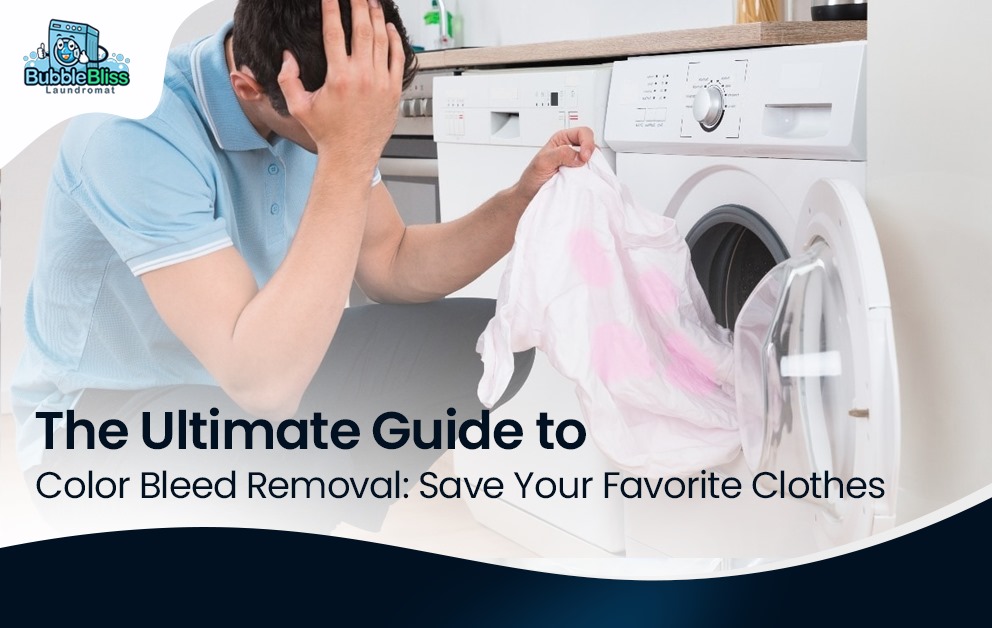Picture this: your new bright item suddenly gifts its color to your favorite piece. This serious laundry color bleeding is frustrating, causing dye transfer and major fabric discoloration. Color bleed can ruin clothes, but only if you do not know the quick fixes. This is the ultimate guide for successful color bleed removal, packed with simple ways to reverse the damage.
What Is Color Bleeding in Laundry?
Let’s get the basics straight. Color bleeding occurs when dyes from one garment are released during a wash cycle and then stain another item. It is essentially an unwanted color swap. This phenomenon, often called dye transfer, is one of the most frustrating laundry mistakes you can make.
The result is typically dullness or a noticeable color streak on the affected item, leading to unwanted color fading on the item that bled.
Why Does Color Bleeding Happen?
Color bleeding usually happens when the fabric dyes are unstable or when the washing conditions are just too intense. The dye molecules become loose and drift through the water.
The main causes include washing in hot water, which opens the fibers and allows the dye to release more easily, or overloading the machine, which does not give clothes enough room to circulate properly. Mixing deep colors with light ones is another major culprit, naturally.
Sometimes, the problem is not your washing technique but rather poor-quality dyes in the garment itself, which cause excessive fabric dye loss. You may also face detergent issues if you use too much or a harsh type on delicate items.
Step 1: Separate and Identify Affected Clothes
The second you notice a color bleed disaster, you must act with speed. The very first step is simple yet critical: immediately stop the wash and start sorting laundry. You need to separate the color-stained clothes from everything else.
Also, pull out the garment that caused the bleed to prevent it from happening again. Think of this as essential laundry organization for your recovery mission. Do not, under any circumstance, let the stained clothes dry.
Step 2: Rinse Immediately in Cold Water
Time is truly of the essence in this scenario. You need to stop the dye from setting, so your next move must be fast. Immediately rinse the affected garment under a stream of cold water.
Running cold water through the fabric helps flush out the loose dye particles before they bond permanently with the fibers. This rapid response is the core of laundry rescue and is critical for color set prevention. Keep rinsing until the water runs clear.
Step 3: Soak in Oxygen-Based Bleach Solution
If the cold rinse was not enough, it is time to bring in the gentle heavy hitters. Mix a solution using an oxygen bleach product, often called a color-safe bleach. These products are formulated to lift color stains without stripping the fabric’s original color. Add the stained item to the solution and let it soak for a few hours, or even overnight, depending on the severity of the stain.
You can often see colors instantly brighten and restore faded colors. Crucially, avoid using chlorine bleach; that stuff is too harsh and can cause permanent damage or remove all color. This solution is a powerful stain remover option.
| Bleach Type | Use Case | Fabric Safety |
| Oxygen Bleach (Color-Safe) | Removing color bleed and stains | Safe for most colored and white fabrics |
| Chlorine Bleach | Sanitizing and whitening | Only safe for pure white cotton; will damage colors |
Step 4: Use Vinegar or Baking Soda for Natural Treatment
For people who prefer a gentler or more natural approach, the kitchen offers excellent natural color restore remedies. White vinegar, a superb vinegar laundry hack, can work wonders. Simply soak the color-bled item in a bucket of cold water mixed with 1 cup of white vinegar. The acid helps to lift and dissolve the offending dye.
Alternatively, you can create a paste using water and baking soda. Applying this baking soda remedy directly to the stained area helps remove mild stains naturally. Leave the treatment on for at least 30 minutes before rinsing thoroughly.
| Natural Remedy | Application | Best For |
| White Vinegar | Soak in 1 cup of vinegar mixed with cold water | Mild to moderate overall color transfer |
| Baking Soda | Create a paste and apply directly to the stain | Targeting specific, localized color spots |
Step 5: Repeat Washing with Gentle Detergent
Once the stain has visibly faded or disappeared, rewash the affected garments. Wash them separately, still in cold water, using a small amount of a high-quality, gentle detergent. This step ensures any residual treatment or dye particles are completely washed away. After the cycle finishes, check the item carefully.
You want to confirm the stain is completely gone. This fabric-safe washing technique helps to restore brightness without causing new damage. If you see even a shadow of the stain remaining, you will need to repeat Steps 3 or 4.
Step 6: Drying Tips for Color-Bled Clothes
This is the most important rule of the recovery process: never machine-dry color-bled clothes until you are 100% sure the stain is gone. Heat is basically the enemy here. Applying heat from a machine dryer or even an iron will instantly set the dye permanently into the fibers, making color bleed removal impossible.
Instead, opt for air drying. Hang the item up and let it dry naturally. This slow process is essential for proper fabric recovery. It gives you one last chance to spot any lingering marks before they become permanent fixtures.
When to Seek Professional Help
Sometimes, the disaster is just too big for a DIY fix. If you have tried the steps above multiple times, or if the garment is a delicate or vintage piece, it is time to call in the experts.
Professionals often have access to specialty chemicals and techniques for serious color restoration that are not available for home use. Services like Bubble Bliss offer dedicated professional laundry service and stain correction.
If the item is marked “Dry Clean Only,” taking it to dry cleaning immediately is always the safest option for correcting the color issue. Do not risk damaging expensive or sentimental items.
How to Prevent Color Bleeding in the Future
Once you have mastered color bleed removal, you will want to master prevention. It is way easier than fixing the mess. The best tip is simple: wash bright and dark items only in a cold wash cycle. This dramatically reduces the chances of prevent dye transfer.
Always turn new or brightly colored items inside out for the first few washes. Using color catchers in your wash load is a genius move, as these sheets absorb any loose dyes before they can stain other clothes.
Finally, make it a habit of testing new garments for colorfastness before the first wash; you can do this by dabbing a hidden seam with a wet cotton swab. Incorporate these basic laundry care tips into your routine.
| Prevention Tip | Action | Benefit |
| Cold Wash | Always use a cold wash cycle for mixed loads | Reduces dye release and prevents prevent dye transfer |
| Color Catchers | Toss a sheet into every mixed load | Traps loose dye molecules before they stain other items |
| Test New Clothes | Dampen an unseen area on new, bright clothes | Confirms colorfastness before the first full wash |
FAQs About Color Bleed Removal
- Can all color stains be removed?
Ans: Most fresh color stains can be removed, especially if you act immediately and avoid using heat. However, older, set-in stains or those on delicate fabrics like silk can be difficult to eliminate completely. Using professional help offers the best chance for full remove color stains.
- Is bleach safe for all fabrics?
Ans: No. Only oxygen-based or color-safe bleach should be used for most laundry items. Chlorine bleach can completely damage or dissolve natural fibers and remove color, so it is not recommended for general washing tips.
End Note
You now have the ultimate playbook for effective color bleed removal. We walked through every step, from the cold rinse to the gentle washing. We encourage you to try these safe, eco-friendly methods to restore clothes and give your wardrobe a second chance.
If you have a delicate item or a particularly stubborn stain, the stress may not be worth it. For professional results and guaranteed laundry stain removal, consider using our service like Bubble Bliss’s specialized color correction service. We can handle the tough stuff so you do not have to.


